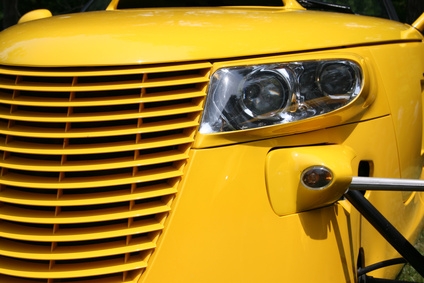
The Chrysler PT Cruiser was introduced in 2001 by Daimler Chrysler Corporation. The PT Cruiser has been produced with a 2.0-liter 4-cylinder, a 2.4 liter 4-cylinder, and a 2.4-liter turbo charged 4-cylinder engine. The PT Cruiser has won prestigious awards such as "Car and Drivers" Ten Best award, and North American Auto Show's Car of the Year award. Replacing the front pads on the PT Cruiser should take about two hours even if you have never performed this project before.
Lift the front of the PT Cruiser with a two-ton or greater capacity jack. Place jack stands beneath both front lower control arms to support the wheels off the ground. Remove both front wheels with a wheel lug wrench. You can set the tires on their backs near the car if you would like to sit on something other than the ground while working on the brakes.
Remove the two caliper bolts from one of side of the PT Cruiser. The caliper bolts are on the rear of the caliper at the top and bottom corners. Use a three-eighths-inch ratchet and socket to remove the bolts.
Place a pry bar against the top of the rotor, and the caliper. Pry gently on the caliper, until it moves slightly. Do not remove the caliper at this moment. Place the pry bar in the opening on the back side of the caliper, between the rotor and the caliper piston. Push the handle of the pry bar away from the car in order to compress the piston. Remove the caliper completely once the caliper piston is compressed.
Set the caliper on the lower control arm. Do not let the caliper hang freely, or it could tear or rupture the rubber brake line leading to the caliper from the body of the car. Remove the old brake pads from the caliper bracket.
Lubricate the caliper slide rails with a tub of caliper grease and an applicator brush where the old pads were sitting. Lubricating the brake parts prior to installing new parts will help ensure even braking and no jammed parts. Install the new brake pads onto the caliper bracket by hand. Lubricate the back sides of both brake pads on the metal shim plate. This will reduce initial brake dust buildup and new brake squeaking.
Push the caliper slide tubes out of the caliper. The slide tubes are metal tubes with rubber grommets at each end. Push the tubes until they protrude from the back side of the caliper, and remove by hand. Dip the caliper slide tubes into the tub of caliper grease to thoroughly grease them. The slide tubes are what the entire caliper moves back and forth upon. If not properly lubricated, the slide tubes will cause the caliper to seize. Reinstall the tubes once they are properly lubricated. Push the tubes flush with the front or inside of the caliper, facing the caliper bracket.
Install the caliper over the new brake pads and the rotor. Install the caliper mounting bolts and tighten them between 60 to 80 foot-lbs of torque. Spray the entire brake assembly down with aerosol brake cleaner to remove greasy fingerprints from contact surfaces like the rotor face.
Repeat Steps 2 through 7 to complete the second side of the vehicle. Reinstall the wheels and tighten the lug nuts only when you have double-checked all of the caliper mounting bolts for security.
Lower the vehicle and tighten all front lug nuts between 90 and 100 foot-lbs of torque. Get in the driver's seat of the vehicle. Pump the brake pedal between 15 and 20 times before starting the engine or trying to drive the vehicle. It is best to pump the brakes right after the project is complete, lest you forget and possibly get into an accident.